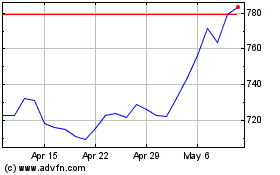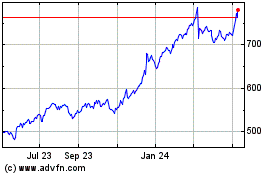Companies struggle to keep up supply of fish as wholesale prices
shoot up sharply
By Lucy Craymer
This article is being republished as part of our daily
reproduction of WSJ.com articles that also appeared in the U.S.
print edition of The Wall Street Journal (July 16, 2020).
HONG KONG -- Tuna fish has surged in popularity thanks to pantry
loading during the coronavirus pandemic, but producers of the
canned fish are dealing with higher prices and other challenges
that are making it difficult to keep up with the increased
demand.
Americans have been buying more canned tuna during the economic
downturn, in part because it is one of the cheapest proteins on the
market, costing as little as $1 for a 5-ounce can. Bumble Bee Foods
said sales of canned and pouched tuna jumped as much as 100% from
mid-March to early April, while Costco Wholesale Corp. put limits
earlier this year on how many tuna containers a customer could
purchase.
Even after the initial feeding frenzy, canned tuna producers say
sales for these products have remained significantly higher than a
year earlier.
Companies have been able to keep retail prices steady for tuna
so far, even though average wholesale prices for tuna were up 41%
from a year earlier in the year through May after reaching decade
lows late last year, according to data from the Food and
Agriculture Organization of the United Nations.
Prices vary depending on where the fish is bought. Skipjack tuna
purchased in Bangkok cost $1,200 a metric ton in June, up 14% from
December 2019 but down from a peak of $1,500 in March, according to
data from Thai Union Group, a global seafood-based food producer
that owns the Chicken of the Sea canned tuna brand.
Tuna has gone the opposite way of wholesale prices for other
seafood, which have broadly declined due to sharp drops in
restaurant demand.
The tuna industry has a very long supply chain. Analysts say
wholesale prices could remain elevated or trend higher in the
coming months due to challenges of getting enough fish to meet the
surge in demand.
More than 40% of the world's commercially caught tuna comes from
the western and central Pacific Ocean, in the waters around tiny
nations such as Tuvalu and Kiribati. The fish are then shipped to
processing plants on islands in the Pacific, in Asia or South
America. Tuna is often canned in a third country before landing on
supermarket shelves.
Tuna stocks have been ample this year, say food-industry
analysts, but border controls and other supply-chain issues are
hampering production.
Pittsburgh-based StarKist Co., which is owned by a South Korean
conglomerate, processes and cans most of its tuna in American
Samoa, a tiny territory that is closer to New Zealand than it is to
the continental U.S.
The company has wanted to increase production, said Andrew Choe,
StarKist's president and chief executive, but it has been unable to
buy tuna from some of its regular suppliers during the pandemic.
Border restrictions and fishing-port closures at some neighboring
Pacific islands -- where StarKist often buys tuna -- have prevented
fishing vessels from coming in and delivering their catch.
Compounding matters, StarKist's plant on American Samoa recently
encountered mechanical issues that took a while to fix, in part
because the company had to charter a plane to fly in people to
bring parts and do the repairs. Then shipments of canned tuna to
the continental U.S. were held up because the ship that services
the archipelago broke down twice and had to be replaced.
"There have been a lot of complaints -- rightly so -- because
they're not getting their products," said Mr. Choe, referring to
retailers. He added that problems at the plant probably could have
been easily and quickly been fixed were it not for the
pandemic.
For decades, the world's largest producers of canned tuna
struggled to reverse falling sales and shed negative perceptions
that their products were old-fashioned, pungent, high in mercury
and environmentally unfriendly. Then the pandemic occurred, and the
20th-century pantry staple became popular again.
Thai Union, the owner of El Segundo, Calif.-based Chicken of the
Sea, said in May that sharply higher sales of canned tuna during
the first quarter helped the group achieve its best operating
performance in years. In March alone, sales of so-called ambient
seafood -- which includes canned products -- jumped 50%.
"People are asking, is this pantry-loading? Is this consumption?
I would say, every pantry-loading leads to higher consumption.
People are not just leaving that in their pantry. They are
consuming it," Joerg Ayrle, Thai Union's chief financial officer,
said on a conference call. He also said the company has released
videos with recipes for various types of tuna fish cakes and tuna
pancakes.
Darian McBain, Thai Union's global director of corporate affairs
and sustainability, said the company expects demand for canned tuna
to remain elevated, though not at the level it experienced earlier
this year.
Chicken of the Sea had to close a canning facility in Lyons,
Ga., for one day last month after a coronavirus outbreak at the
plant. "It's our new normal," Dr. McBain said.
At a Bumble Bee Foods facility in Santa Fe Springs, Calif., the
company has added Saturday shifts for workers to meet increased
demand.
Todd Putman, Bumble Bee Foods' executive vice president and
chief growth officer, said the company's tuna stocks are running
low.
"The product is available; it's just a matter of getting it into
the U.S.," Mr. Putman said. "Our supply chain is strained."
Write to Lucy Craymer at Lucy.Craymer@wsj.com
(END) Dow Jones Newswires
July 16, 2020 02:47 ET (06:47 GMT)
Copyright (c) 2020 Dow Jones & Company, Inc.
Costco Wholesale (NASDAQ:COST)
Historical Stock Chart
From Mar 2024 to Apr 2024

Costco Wholesale (NASDAQ:COST)
Historical Stock Chart
From Apr 2023 to Apr 2024
